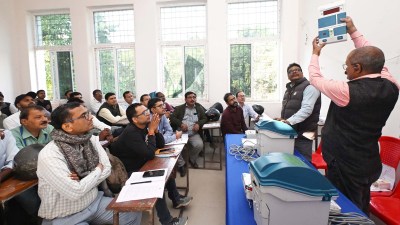Japanese filmmaker Hayao Miyazaki, considered one of the greatest animators and directors, has won the 2024 Ramon Magsaysay Award. Named after the former President of the Philippines, the awards “honor greatness of spirit shown in service to the peoples of Asia”, covering fields such as community service and arts.

The award citation called Miyazaki “one of the industry’s foremost exponents of animated films made expressly for children but with a much broader appeal.”
Who is Hayao Miyazaki?
Miyazaki was born in 1941 in Tokyo. His father was the director of a company that manufactured parts for fighter planes during World War II. In his book Starting Point: 1979 to 1996, Miyazaki wrote that some of his earliest memories are of “bombed-out cities”. By age four, he had witnessed the bombing of Utsunomiya.
Story continues below this ad
Despite having an affinity for manga (a popular style of Japanese comics and graphic novels), Miyazaki initially had trouble drawing people. He spent years drawing planes, battleships and tanks, which found their way into his cinema as well. After studying economics and political science, he began his career as an animator in 1963.
Before the creation of his production company Studio Ghibli, Miyazaki’s major projects included the long-running series World Masterpiece Theater; and Future Boy Conan, which he directed. In the 1969 film The Wonderful World of Puss ‘n Boots, he worked with other top animators in Japan to execute distinct visual sequences.
What is Studio Ghibli?
Miyazaki, along with director Isao Takahata and producer Toshio Suzuki, founded Studio Ghibli in 1985 under the publishing company Tokuma Shoten. Most of their films were directed by Miyazaki, with Takahata being the second-biggest contributor.
Miyazaki’s first two films with the studio, Castle in the Sky (1986) and My Neighbor Totoro (1988), failed to do well commercially. It was only with Kiki’s Delivery Service in 1989 that the studio tasted success.
Story continues below this ad
The Magsaysay Award citation notes: “More than being commercial successes—three Ghibli productions are among Japan’s ten top-grossing films—these are works that display a deep understanding of the human condition, engaging their viewers to reflect on their own situation and exercise their humanity.”
Their most famous film is perhaps Spirited Away (2001). It tells the story of Chihiro, a 10-year-old girl who mysteriously gets trapped in the world of ‘Kami’ (spirits of Japanese folklore) and must try to return to the human world. Spirited Away was the first non-English film to win the Academy Award for Best Animated Feature, although Miyazaki refused to attend the award ceremony over his opposition to the Iraq War.
Studio Ghibli has also become synonymous with gentle, aesthetically pleasing visuals — many of which are meticulously hand-drawn by Miyazaki even in the digital age.
Recurring themes in Hayao Miyazaki’s work
Miyazaki’s work was heavily steeped in the changing lives of Japanese people post World War II, which is most obvious in his obsession with planes in Porco Rosso (1992).
Story continues below this ad
A major theme in his films is pacifism. In his essay ‘A Pig, the State and War: Porco Rosso’ for the journal Animation Studies, author Daisuke Akimoto described Spirited Away as “anti-war propaganda”, saying that the “fundamental political message of the film is not only anti-fascism, but also anti-war pacifism”. In Princess Mononoke (1997), the protagonist goes against tradition and history to try and end conflict between communities.
Environmentalism also finds a prominent place in Miyazaki’s filmography. Margaret Talbot wrote in The New Yorker that he perceives modern culture as “thin and shallow and fake”, and is generally distrustful of technology. In 2008, Miyazaki told The Japan Times that he felt very frustrated growing up because he saw nature being destroyed “in the name of economic progress”.
Ram Prakash Dwivedi, a professor of journalism and mass communication at the University of Delhi, has talked about the presence of values propagated by Mahatma Gandhi in Miyazaki’s filmography in ‘A Discourse on Modern Civilization: The Cinema of Hayao Miyazaki and Gandhi’.
“Mahatma Gandhi by his political action and spiritual thought and Hayao Miyazaki, by his film direction, production and modern ideas were trying to throw light on the crisis of our civilization. Philosophy and ideas of Buddha and modern democratic values of liberty, equality, and fraternity are the common guiding forces for both of them,” he wrote.
Story continues below this ad
Women in Studio Ghibli films
Strong-minded women characters are another major feature of Ghibli films. “Miyazaki’s girls display formidable know-how and independence. They take on jobs, organise households, fight battles and rescue boys from near death — all matter-of-factly, without ever trumpeting notions of girl power,” The New York Times said.
His mother Yoshiko inspired many characters, such as Captain Dola in Castle in the Sky. The mother Yasuko in My Neighbor Totoro, like his own mother, looked after their children despite her illness (Yoshiko had spinal tuberculosis). Miyazaki has also said that Sophie from Howl’s Moving Castle (2004), and Toki from Ponyo (2008) were modelled on Yoshiko.
He also chose to tell coming-of-age stories about young women without resorting to sexualisation or fluff, a phenomenon that is still rare today, especially in stories about women told by men. His heroines have a strong will, a good sense of humour, and an ability to navigate the complexities of the world while still being true to themselves.
Just like his depiction of young women, Miyazaki’s younger characters also have layers and nuances that are typically not seen in portrayals of children. The children in his films display a sense of innocence and wide-eyed wonder, which co-exists with logic and clear-headedness, and also at times, maturity.
Story continues below this ad
He once said, “I want to depict the reality of present-day children in Japan — including their desire — and make films that will inspire heartfelt enjoyment. This is something fundamental, something we should never forget.”
This goes hand-in-hand with Miyazaki’s disapproval of the Japanese anime industry as it exists today. He has often said that the animators do not create from real life, and are more obsessed with the images they see of public obsession with manga, anime, video games, etc. In Japanese popular culture, such people are known as ‘otaku’ and are believed to lack adequate social and other life skills.
Miyazaki has also been influenced by leftist ideologies and said that he considers Karl Marx’s communism in line with his own values. Many conservatives in Japan have criticised his films.
This is an updated version of an explainer first published in 2023.








































